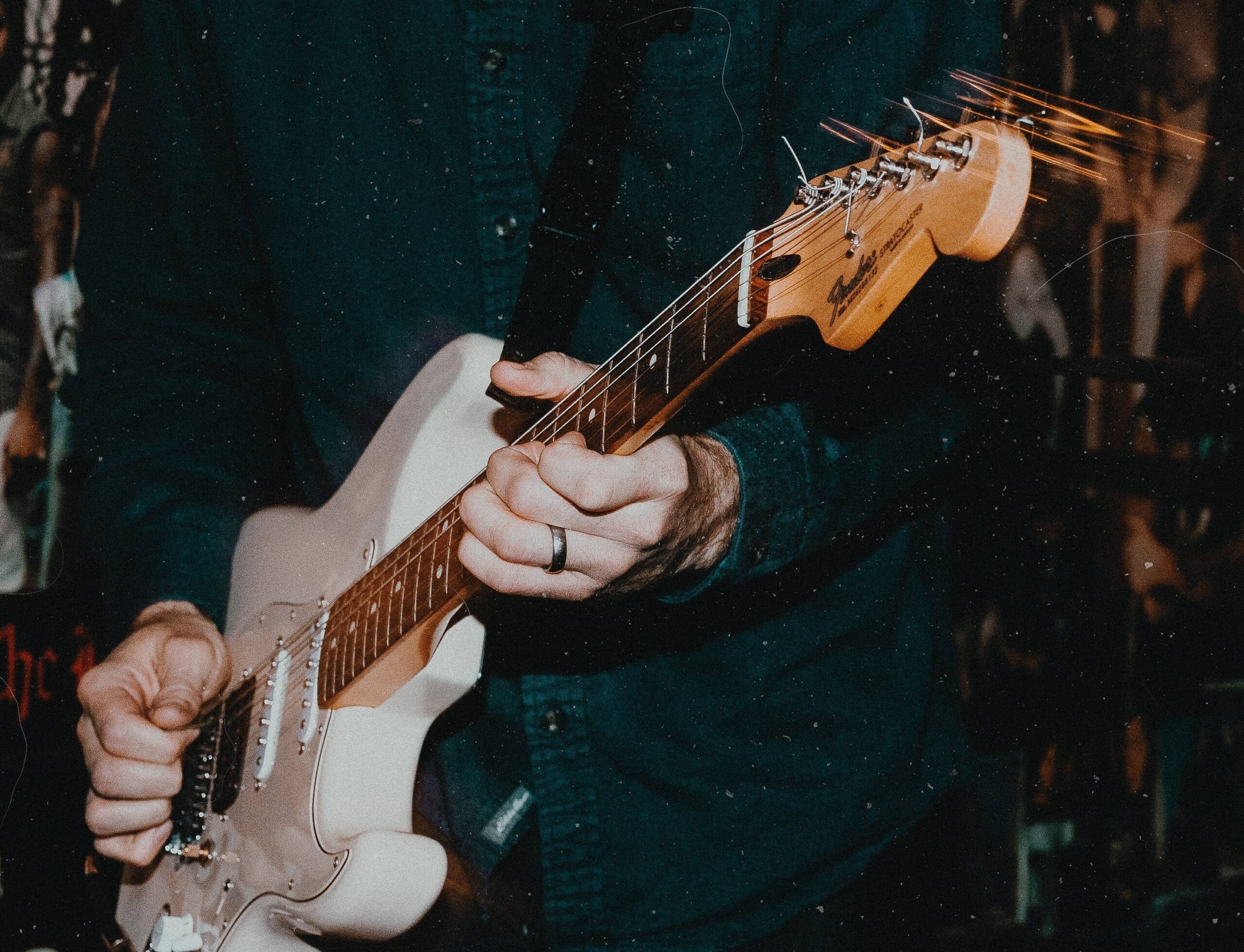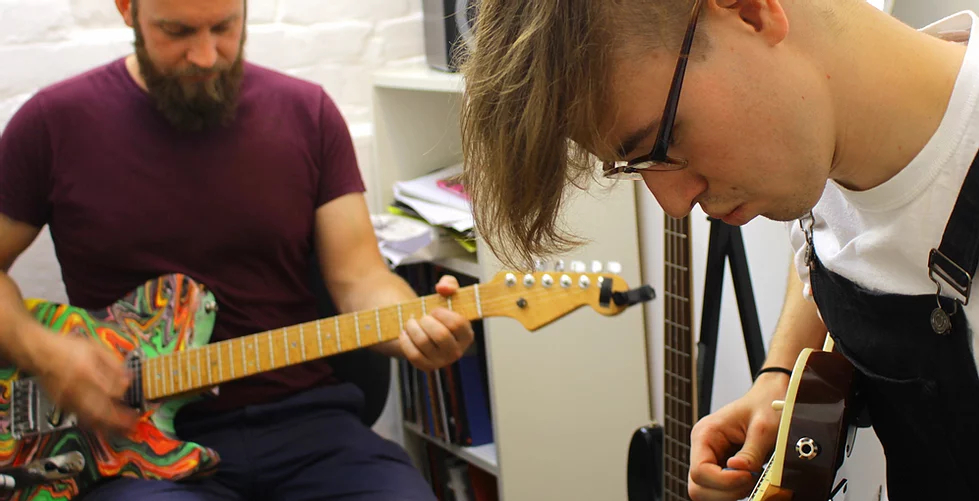When you first pick up your new string instrument, inevitably you’ll be wondering exactly how to play guitar. You’re in for an exciting journey ahead! Learning an instrument is a fantastic, life-long skill to develop and what’s more, it’s a fun, enjoyable process when working with the right teacher.
Whilst you certainly don’t need to come with any musical experience before your first lesson as you’ll be taken through every step, many people like to have some basic understanding to avoid feeling overwhelmed in their initial session. So, in this article, we’re taking you through some of the basics that will give you a glimpse into what is to come allowing you to prepare for your first lesson.
#1 Learning the names of your guitar’s parts
Before you start playing, your teacher will tell you the parts of the guitar. This will allow you to follow along in a lesson with more ease which is why it is such a crucial first step. There’s no point rushing into advanced chords or riffs without building a solid foundation that will see you set up to progress your playing. It can seem a little confusing at first as acoustic, electric and bass all have different components but let’s delve into the essential terminology that these all share which will help you when figuring out how to play guitar:
- Body: Perhaps the most obvious! This is the main ‘curvy’ part of the guitar – on an acoustic this is hollow but on an electric, this can be hollow, semi-hollow or solid.
- Neck: The other main component of your instrument, it’s the long, thin part and typically is held in your left hand (if you’re right-handed!)
- Fretboard: This is the area of the neck that is directly underneath the strings. It’s shaped and marked so that strings can be depressed at certain points to create certain notes. Frets are the raised bits of wire the run across the fretboard’s width and a standard guitar has 22 of these.
- Inlays: Decorative markers, usually simple dots, that allow you to mark the 3rd, 5th, 7th, 9th, 12th frets.
- Tuners: The parts of your guitar that allow you to tune it, the flat, ‘key’ part is attached to a peg, on which the string is wound. Tightening or loosening it changes the tension in the strings and as a result, changes the pitch.
#2 Holding your guitar correctly
It may not seem like a big deal, but holding your guitar correctly is absolutely crucial to your development. So, it can be a good idea to get comfortable with this positioning before your first lesson, aiding you on your journey on how to play guitar. We recommend following these steps:
- Sit with your back straight and your legs at a 90-degree angle on a chair that allows you to move your arms freely.
- Make sure your elbow comes over the ridge of the guitar, this will help you strum correctly so you need to ensure you can move your hand back and forth over the strings unrestricted.
- Ensure your guitar is in a straight line across your body; if the neck is pulled back you won’t have the full range of motion required to play, and too far for forward will see you chasing chords.
- Avoid tucking your fretting hand (the one holding the neck) or placing this on your lap, you need it free to be able to reach chords fully – try purposely extending it out.
- Practice placing your fingers tips on the strings, you want to be making contact as close to the nail as is possible to create stronger sounds.

#3 Learning what a chord is
It’s likely you’ve heard of the word ‘chord’ before, even if you have little prior musical knowledge. But, what actually is it? A chord is made up of two or more notes played together simultaneously. There are two types, minor and major – a minor chord is associated with dark or moody music, whilst a major is typically a bright, happy sound. We can tell the two apart in written music as:
- Major chords are referred to by the chord’s letter name. So a G major chord is ‘G’.
- Minor chords have a small ‘m’ after the letter name. So ‘A minor’ is written as ‘Am’.
In your first few lessons, you’ll concentrate on E, G, C, A, and D chords which will provide you with the fundamentals to play a variety of popular songs. Your teacher will also provide you with chord diagrams to assist your practice – this is a simple diagram that will remind you which string and fret to place your fingers. Your fingers will be numbered through one to four as:
1 – Index
2- Middle
3- Ring
4 Pinky
#4 Understanding how to read TAB
Whilst at first these symbols and numbers make little sense, TAB (or tablature) is incredibly simple to grasp and will allow you in the future to play a variety of different songs.
Standard guitar TAB has six horizontal lines to represent the six strings on the guitar – a bass will have four. The key point to remember is that the top line on a guitar TAB matches the highest pitch string on your guitar and the lowest line matches the lowest pitch string on your guitar.
The numbers on TAB represent the fret numbers on a string. A 5 would mean the fifth fret on your guitar, a 12 would be the twelfth fret and 0 would mean an open string. When numbers are stacked on top of each other, it is telling you to play those numbers at the same time – simply put, play a chord.
#5 Practicing basic finger exercises
Trying a basic finger exercise before your lesson will allow you to build an understanding of how much pressure to apply to create a clear sound and how to reach strings – plus, it can help reduce strain and you begin building up muscle.
Place your 4 fingers on the highest string and place each of these down one at a time on the first fret, then once you’ve completed these four movements, move on to the next fret and the next string – repeating the four actions:

#6 Creating a practice schedule
When you are learning how to play guitar, whether you are a beginner or have some prior experience, one of the most overlooked steps before your first lesson is taking the time to create a practice schedule – one that you’ll stick to!
A structured schedule can keep you motivated and enable you to continue making steady progress. Ideally, you should pick your guitar up every day but we know this isn’t always viable; however, the more you get into the habit, the more enjoyment you’ll get out of your practice and lessons. We’ve created an example that you can personalise to your own daily lifestyle, ready for you to utilise after your first lesson:
Monday – 1-2-1 guitar lesson with your Guitarlab teacher
Tuesday – 30 minute practise related to your lesson
Wednesday – Break
Thursday – 15 minutes practising finger placement
Friday – Watch your favourite guitarist on YouTube, 20 minutes reading TAB and experimenting
Saturday – 30 minute practise related to your lesson
Sunday – Break
You may include more breaks or more practice depending on how quickly you are looking to develop, but if you can get into a consistent routine you will reap the benefits in your lessons.
How to play guitar: Prepping for your first lesson
There is certainly no requirement to follow any of the above steps before your first lesson! If you are ready and willing to begin playing, your teacher will be able to provide all the information you need in your first session from how to hold the guitar and what a chord is, to formulating a practice schedule that suits you. However, there is no harm in getting ahead and learning a few basics as this may put you more at ease, we know the initial session may seem like a lot of information is coming your way. It is completely down to your personal preference as an individual, the most important thing is to have fun! We’ll take your learning at your own pace with personalised lesson plans and targets. So, whether you want to become the next great Jimi Hendrix or just want to be able to strum along to your favourite tunes, don’t be afraid to take the first steps towards learning guitar! Be that waiting until your first lesson or getting to grips with the key basics beforehand.
Our Guitarlab teachers have over 50 years of experience between them, we understand how to comfortably tailor the learning process to suit your needs. And, we offer both online and in-person tuition to suit your schedule! Contact the team at Guitarlab at 01483 239935 or 07429 074072 and we’ll be more than happy to discuss our teaching services with you.





